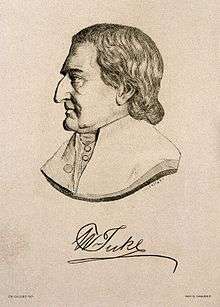William Tuke

William Tuke (24 March 1732 – 1822) was an English businessman, philanthropist and Quaker. He was instrumental in the development of more humane methods in the custody and care of people with mental disorders, an approach that came to be known as moral treatment.
Career
Tuke was born in York to a leading Quaker family. He went into the family tea and coffee merchant business that had been started by Mary Tuke in 1725, and she passed it on to him in 1755. It became part of Twinings tea company after the second world war.
In 1754 he married Elizabeth Hoyland, and in 1765 he married Esther Maud whose "talents for leadership, ministerial work and educational advancement became a vital source of influence upon William's son Henry" (Wright, Friends in York, p. 21).
Following the death of Hannah Mills in appalling conditions in York Lunatic Asylum in 1790, Tuke was asked to take the lead in Quaker efforts to develop a more humane alternative. He solicited funds from friends, Quakers, and physicians. He spent two years discussing plans with the local Quaker group (York Monthly Meeting) describing the fundamental principles of the proposed institution. It opened in 1796 as the York Retreat. The approach was widely derided at first, and William Tuke noted that "All men seem to desert me."[1] However, it became famous around the world as a model of more humane and psychologically-based approaches. William's son, Henry Tuke co-founded the Retreat and continued his work, as did his grandson, Samuel Tuke, who also helped publicize the work and the term, "moral treatment".
Tuke, together with Godfrey Higgins set about investigating the appalling conditions within the York Lunatic asylum after Hannah Mills' death, and successfully had it deemed unfit for purpose due to the squalor the patients lived in.
Tuke was one of a few voices in Britain opposing the East India Company for its inhumane impact on other countries.[2] He was also a subscriber to the African Institution, the body which set out to create a viable, civilized refuge for freed slaves in Sierra Leone, Africa.[3]:182
References
External links
- Claus Bernet (2009). "William Tuke". In Bautz, Traugott. Biographisch-Bibliographisches Kirchenlexikon (BBKL) (in German). 30. Nordhausen: Bautz. col. 1527-1530. ISBN 978-3-88309-478-6.
- BBC Website - brief William Tuke biography
- York Quaker memorial statement of 1823 concerning William Tuke from Google Book search.
- The Tuke Institute an independent charity
![]() This article incorporates text from a publication now in the public domain: Chisholm, Hugh, ed. (1911). "article name needed". Encyclopædia Britannica (11th ed.). Cambridge University Press.
This article incorporates text from a publication now in the public domain: Chisholm, Hugh, ed. (1911). "article name needed". Encyclopædia Britannica (11th ed.). Cambridge University Press.